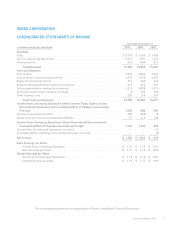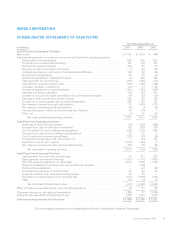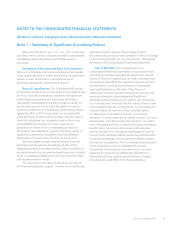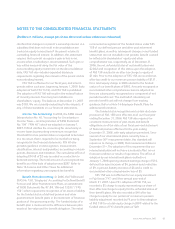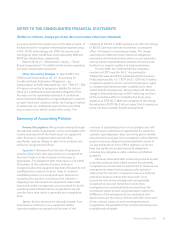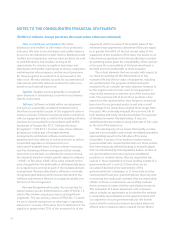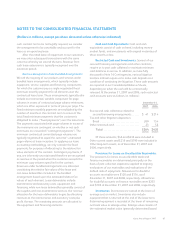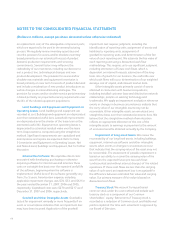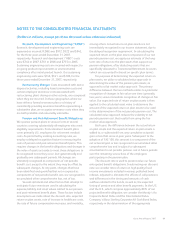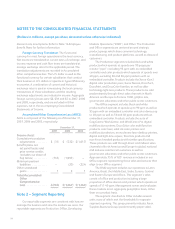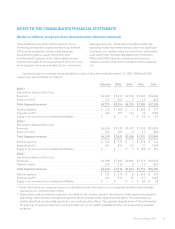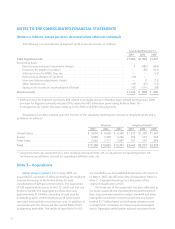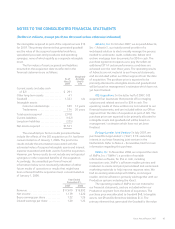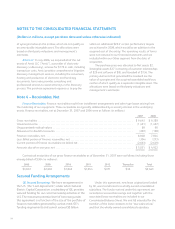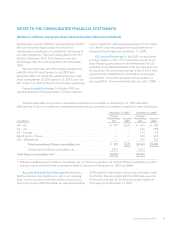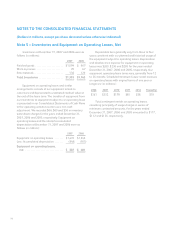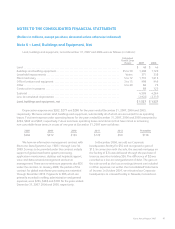Xerox 2007 Annual Report Download - page 89
Download and view the complete annual report
Please find page 89 of the 2007 Xerox annual report below. You can navigate through the pages in the report by either clicking on the pages listed below, or by using the keyword search tool below to find specific information within the annual report.
NOTES TO THE CONSOLIDATED FINANCIAL STATEMENTS
(Dollars in millions, except per-share data and unless otherwise indicated)
such contract terms are not legally required, we consider
the arrangement to be cancelable and account for the
lease as an operating lease.
After the initial lease of equipment to our customers,
we may enter subsequent transactions with the same
customer whereby we extend the term. Revenue from
such lease extensions is typically recognized over the
extension period.
Revenue Recognition Under Bundled Arrangements:
We sell the majority of our products and services under
bundled lease arrangements, which typically include
equipment, service, supplies and financing components
for which the customer pays a single negotiated fixed
minimum monthly payment for all elements over the
contractual lease term. These arrangements typically also
include an incremental, variable component for page
volumes in excess of contractual page volume minimums,
which are often expressed in terms of price per page. The
fixed minimum monthly payments are multiplied by the
number of months in the contract term to arrive at the
total fixed minimum payments that the customer is
obligated to make (“fixed payments”) over the lease term.
The payments associated with page volumes in excess of
the minimums are contingent on whether or not such
minimums are exceeded (“contingent payments”). The
minimum contractual committed page volumes are
typically negotiated to equal the customer’s estimated
page volume at lease inception. In applying our lease
accounting methodology, we only consider the fixed
payments for purposes of allocating to the relative fair
value elements of the contract. Contingent payments, if
any, are inherently uncertain and therefore are recognized
as revenue in the period when the customer exceeds the
minimum copy volumes specified in the contract.
Revenues under bundled arrangements are allocated
considering the relative fair values of the lease and
non-lease deliverables included in the bundled
arrangement based upon the estimated relative fair
values of each element. Lease deliverables include
maintenance and executory costs, equipment and
financing, while non-lease deliverables generally consist of
the supplies and non-maintenance services. Our revenue
allocation for the lease deliverables begins by allocating
revenues to the maintenance and executory costs plus
profit thereon. The remaining amounts are allocated to
the equipment and financing elements.
Cash and Cash Equivalents: Cash and cash
equivalents consist of cash on hand, including money-
market funds, and investments with original maturities of
three months or less.
Restricted Cash and Investments: Several of our
secured financing arrangements and other contracts,
require us to post cash collateral or maintain minimum
cash balances in escrow. In addition, as more fully
discussed in Note 16 Contingencies, various litigation
matters in Brazil require us to make cash deposits as a
condition of continuing the litigation. These cash amounts
are reported in our Consolidated Balance Sheets,
depending on when the cash will be contractually
released. At December 31, 2007 and 2006, such restricted
cash amounts were as follows (in millions):
December 31,
2007 2006
Escrow and cash collections related to
secured borrowing arrangements ...... $ 41 $214
Tax and other litigation deposits in
Brazil ............................... 200 154
Other restricted cash ................... 23 58
Total ........................... $264 $426
Of these amounts, $45 and $236 were included in
Other current assets and $219 and $190 were included in
Other long-term assets, as of December 31, 2007 and
2006, respectively.
Provisions for Losses on Uncollectible Receivables:
The provisions for losses on uncollectible trade and
finance receivables are determined principally on the
basis of past collection experience applied to ongoing
evaluations of our receivables and evaluations of the
default risks of repayment. Allowances for doubtful
accounts receivable were $128 and $116, as of
December 31, 2007 and 2006, respectively. Allowances
for doubtful accounts on finance receivables were $203
and $198 at December 31, 2007 and 2006, respectively.
Inventories: Inventories are carried at the lower of
average cost or market. Inventories also include
equipment that is returned at the end of the lease term.
Returned equipment is recorded at the lower of remaining
net book value or salvage value. Salvage value consists of
the estimated market value (generally determined based
Xerox Annual Report 2007 87


